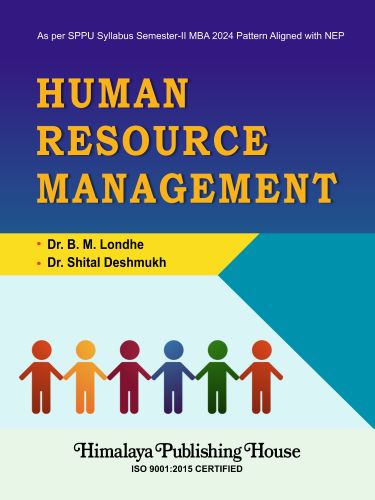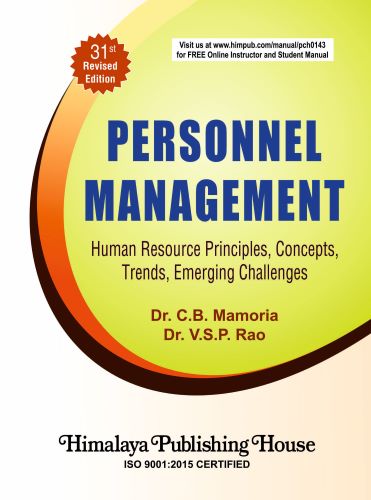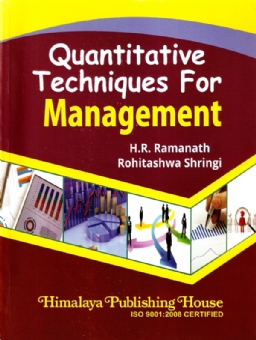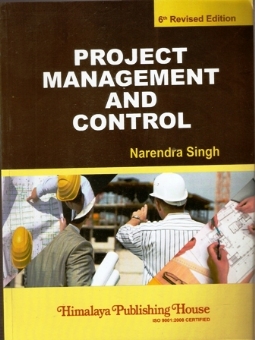The field of Human Resource Management (HRM) has evolved into a dynamic and essential domain within organisational success, making it a cornerstone of management education. This book, aligned with the SPPU MBA 2024 pattern and the guidelines of the National Education Policy (NEP) 2020, offers a comprehensive approach to understanding HRM in the modern era. By blending traditional concepts with contemporary practices and integrating Indian Knowledge System (IKS) principles, this book provides a holistic perspective tailored to equip MBA students with both theoretical insights and practical skills.
The book begins with an exploration of the Concept, Objectives, and Scope of HRM, offering insights into its features, policies, and practices. It delves into the challenges faced by HR professionals in today’s dynamic environment, emphasising the critical role HRM plays in achieving organisational success. Through relatable examples and case studies, the section sets the stage for understanding HRM’s foundational principles and strategic importance.
Subsequent chapters on Human Resource Planning (HRP) address its objectives, process, and barriers while linking it to job analysis and design. Special emphasis is placed on differentiating job enrichment and job enlargement, supported by real-world scenarios. By introducing IKS concepts like Nishkam Karma and Dharma, the content fosters a culturally rooted approach to designing effective HR strategies, making this section both globally relevant and locally contextualised.
The Recruitment and Retention segment offers insights into recruitment strategies, selection processes, and employee retention methods. With practical applications of IKS principles to recruitment and succession planning, this section emphasises the need for a value-based and inclusive approach to managing talent. Concepts like induction, career planning, and transfer policies are thoroughly explored, ensuring students develop a robust understanding of HR lifecycle management.
In addressing Managing Employee Performance and Training, the book combines modern appraisal methods and IKS-aligned performance management techniques. Training and development processes are presented comprehensively, including emerging trends like e-learning and tools like the Kirkpatrick model for evaluating training effectiveness. This section also covers the scope of training in organisations, its role in aligning individual growth with organisational objectives, and its key objectives like skill enhancement, safety compliance, and leadership development. Additionally, the application of IKS principles to training, such as Shreyas (excellence) and Seva (service), provides a culturally enriched framework for employee learning and growth. By bridging traditional methods with advanced technologies and holistic approaches, this section equips students with future-ready strategies to manage and develop talent effectively.
Finally, the chapter on Compensation Management delves into salary structures, incentives, and grievance redressal systems, covering financial and non-financial motivators. Incorporating current trends in compensation equips students to design competitive reward systems that attract and retain top talent. Topics like employee separation, including retirement and voluntary retirement schemes (VRS), are discussed to offer a well-rounded view of HRM responsibilities.
This book aims to serve as a practical and theoretical guide for MBA students, preparing them to navigate the complexities of HRM in diverse organisational contexts. By integrating NEP-aligned learning objectives and contemporary HR challenges, this text aspires to develop competent, ethical, and innovative HR professionals who can lead organisations toward sustainable growth.
Contents –
1. Human Resource Management: Concept and Challenges
1.1 Introduction to Human Resource Management (HRM)
1.2 Objectives of Human Resource Management (HRM)
1.3 Scope of Human Resource Management (HRM)
1.4 Features of Human Resource Management (HRM)
1.5 Role of Human Resource Management (HRM)
1.6 Importance of Human Resource Management (HRM)
1.7 Policies and Practices of Human Resource Management (HRM)
1.8 Functions of Human Resource Management (HRM)
1.9 Challenges of Human Resource Management (HRM)
1.10 Case Studies
1.11 Summary of the Unit
1.12 Theory Questions
1.13 Multiple Choice Questions
2. Human Resource Planning
2.1 Introduction to Human Resource Planning (HRP)
2.2 Meaning of Human Resource Planning (HRP)
2.3 Definitions of Human Resource Planning (HRP)
2.4 Objectives of Human Resource Planning (HRP)
2.5 Need for Human Resource Planning (HRP)
2.6 Importance of Human Resource Planning (HRP)
2.7 Process of Human Resource Planning (HRP)
2.8 Barriers to Human Resource Planning
2.9 Meaning of Job Analysis
2.10 Job Analysis Process
2.11 Contents of Job Description
2.12 Contents of Job Specification
2.13 Meaning of Job Design
2.14 Factors Affecting Job Design
2.15 Job Enrichment and Job Enlargement
2.16 Case Studies
2.17 Summary of the Unit
2.18 Theory Questions
2.19 Multiple Choice Questions
3. Recruitment and Retention
3.1 Introduction and Meaning of Recruitment
3.2 Sources of Recruitment
3.3 Difference Between Recruitment and Selection
3.4 Applying IKS (Indian Knowledge System) Principles to Recruitment
3.5 Process of Recruitment and Selection
3.6 The Concept of Induction and Orientation
3.7 Meaning of Career Planning
3.8 Process of Career Planning
3.9 Meaning of Succession Planning
3.10 Process of Succession Planning
3.11 Meaning of Transfer
3.12 Meaning of Promotion
3.13 Meaning of Employee Retention
3.14 Importance of Employee Retention
3.15 Key Strategies for Employee Retention
3.16 Case Studies
3.17 Summary of the Unit
3.18 Theory Questions
3.19 Multiple Choice Questions
4. Managing Employee Performance and Training
4.1 Introduction to Managing Employee Performance and Training
4.2 Meaning of Performance Appraisal and Performance Management
4.3 Definitions of Performance Appraisal and Performance Management
4.4 Objectives of Performance Appraisal and Performance Management
4.5 Importance of Performance Appraisal and Performance Management
4.6 Applying IKS (Indian Knowledge System) Principles to Performance and Rewards
4.7 Appraisal Process
4.8 Appraisal Methods
4.9 Meaning of Training and Development
4.10 Definitions of Training
4.11 Scope of Training in Organisations
4.12 Role of Training in Organisations
4.13 Objectives of Training
4.14 Applying IKS (Indian Knowledge System) Principles to Training
4.15 Training and Development Process
4.16 Training Need Assessment (TNA)
4.17 Types of Training
4.18 Difference Between Training and Development
4.19 Method of Training
4.20 E-Learning
4.21 Benefits of Training
4.22 Evaluation of Training Effectiveness: Kirkpatrick Model
4.23 Case Studies
4.24 Summary of the Unit
4.25 Theory Questions
4.26 Multiple Choice Questions
5. Compensation Management
5.1 Introduction to Compensation Management
5.2 Objectives of Compensation Management
5.3 Importance of Compensation Management
5.4 Process of Compensation Management
5.5 Current Trends in Compensation
5.6 Components of Salary
5.7 Meaning of Incentives and Benefits
5.8 Financial and Non-Financial Incentives
5.9 Meaning of Fringe Benefits
5.10 Employee Separation
5.11 Retirement
5.12 Termination
5.13 Voluntary Retirement Scheme (VRS)
5.14 Suspension
5.15 Meaning of Grievance
5.16 Effects of Grievance
5.17 Grievance Redressal Procedure
5.18 Case Studies
5.19 Summary of the Unit
5.20 Theory Questions
5.21 Multiple Choice Questions







